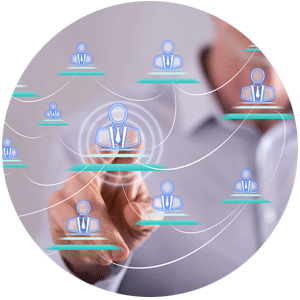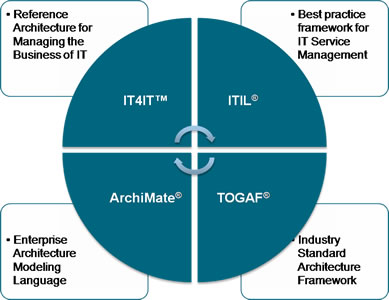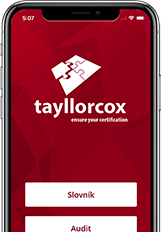Co je IT4IT
Představte životní cyklus služeb IT novým výkonným způsobem. Poskytují chybějící spojení mezi průvodci osvědčenými postupy průmyslového standardu a technologickým rámcem a nástroji, které pohánějí ekosystém správy služeb. Poskytují nový základ toho, jak organizovat a provozovat IT.

About IT4IT
IT4IT, an Open Group standard, provides a vendor-neutral, technology-agnostic, and industry-agnostic reference architecture for managing the business of IT, enabling insight for continuous improvement.
- IT4IT is industry-independent to solve the same problems for everyone.
- IT4IT is designed for existing landscapes and accommodates new IT paradigms such as cloud-brokering, DevOps, Bimodal IT, Agile, and Lean IT.
- IT4IT provides the capabilities for managing the business of IT that will enable IT execution across the entire value chain in a better, faster, cheaper way with less risk.
- IT4IT complements existing process frameworks and methodologies (e.g., ITIL®, COBIT®, TOGAF®) by taking a data-focused and solution oriented implementation model perspective, essentially specifying what information is needed and how IT activities can be automated across the entire value chain.

What is IT4IT
What is management IT4IT
The IT function needs to be managed similar to the business having its own value chain, processes, and information systems. IT4IT (or IT for the IT function) refers to all the capabilities you need to manage IT services throughout its entire lifecycle.
Similar to the business using IT to support or automate its business processes, the IT organization uses IT to support and automate IT management processes.
This includes information systems such as a Project Portfolio Management (PPM) system, development and testing tools, a Configuration Management Database (CMDB), or an IT Service Management (ITSM) system for managing incidents, problems, and changes. All these IT management tools represent “IT for the IT organization”, therefore referred to as IT4IT.
The IT organization is becoming more dependent upon these information systems to automate IT management activities such as build, test, deploy, monitor, and perform automated recovery. Due to the growing importance of IT management to demonstrate the value of IT, but also due to its increase in complexity, there is need to acquire new skills and competences within the IT organization to deliver these integrated IT4IT solutions.

Benefits
The IT4IT Reference Architecture describes how the new IT function should be managed to optimize the value of IT for the business. Like a business, IT’s strategic goal is to create value via IT. This value can come through enabling the business to develop innovative products and/or services, expanding markets (growth strategy), or helping the business become more efficient and cost-effective (productivity).
The IT4IT Reference Architecture enables a more streamlined, transparent, and automated IT function across the entire IT value chain.
Both the enterprise’s operating expenditure and capital expenditure are reduced. Operating expenditure is reduced by making both IT operations and business operations more efficient. The improvement in IT development and operations efficiency is realized by improving the information exchange across all parts of the IT function as well as automating IT management tasks.

Adaptability
Improving the adaptability of the IT operating model and therefore reducing the impact and cost of changes also reduce IT operating expenditure. The efficiency improvement in business operations is realized by reducing the number and size of IT-related business disruptions, and by accelerated deployment of any IT functionality that improves business operations efficiency. Rationalizing the information systems used to manage and support the IT function reduces capital expenditure. For enterprises with a large IT function, an IT cost reduction of between 5% and 20% is feasible.
The enterprise’s risk profile is improved by greater transparency and tighter control of IT services throughout its lifecycle and therefore more predictable costs, delivery, and quality of IT services, leading in turn to more predictable business operations.
Improving business operations, enhancing competitive advantage, and boosting customer loyalty by quicker introduction of new or improved products realize the improvement of the enterprise’s revenue. Customer loyalty is improved by more reliable IT services that impact customers directly or indirectly. Products that depend on IT can be launched quicker due to the improved throughput of IT operations.
IT4IT Relationship
While existing frameworks and standards have placed their main emphasis on process, this standard is process-agnostic, focused instead on the data needed to manage a service through its lifecycle.
IT4IT is neutral with respect to development and delivery models. It is intended to support Agile as well as waterfall approaches, and lean process approaches as well as fully elaborated IT service management process models.
The IT4IT Reference Architecture relates to TOGAF, ArchiMate, and ITIL as shown above.
TOGAF®, ArchiMate® logo and IT4IT™ logo and The Open Group Certification logo (Open O and checkTM) are trademarks of The Open Group.



